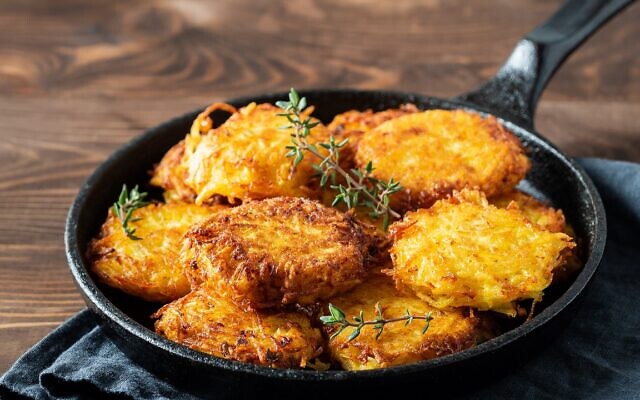What’s Jewish About…Latkes?
How latkes became a Chanukah tradition
Robyn Spizman Gerson is a New York Times best-selling author of many books, including “When Words Matter Most.” She is also a communications professional and well-known media personality, having appeared often locally on “Atlanta and Company” and nationally on NBC’s “Today” show. For more information go to www.robynspizman.com.

In search of the perfect latke and an understanding of this Chanukah holiday delicacy, we asked two rabbis and a pair of seasoned cooks for the inside scoop. We thank them “a-latke”!
What’s the history of the tradition of eating latkes on Chanukah?
According to Rabbi Joshua Heller, senior rabbi of Congregation B’nai Torah, “Latkes are among the most commonly consumed Chanukah foods. I’ve heard the story that the oil is to remember the oil of the Chanukah miracle, and potatoes were the simple food eaten by the Maccabees. The first time a Jew met a potato was the 1500s, and latkes as we eat them today are a very late add to the Chanukah tradition. The Shulchan Aruch (a classic Jewish law code of the 1500s) cites cheese as the most important Chanukah food, in remembrance of Judith, the heroine of a book that did not make it into the bible.”
Tell us about the real heroine behind the story of the latke.
Rabbi Heller: As the ancient story tells us, Babylonian king Nebuchadnezzar sent his general Holofernes to besiege the Jewish city of Bethulia. Judith, described as a beautiful young widow, saved her people by presenting herself to Holofernes, in order to slay him herself. While the story was originally set in earlier times, later traditions placed it as the precursor to the Chanukah story and added that cheese was on the menu of Holofernes’ last meal. To remember this story, Spanish and Italian Jews made cheese pancakes on Chanukah. By the time the custom of fried food reached Poland, potatoes were the most available fry-able ingredient, and many American Jews of northern European descent now see the latke as the traditional food. As you enjoy your latkes, let the oil remind you of the Chanukah miracle and the potatoes remind you of the creativity of our European ancestors, but be sure to add cheese or sour cream, to remember Judith, an oft-forgotten heroine of the season.”
Rabbi Micah Lapidus, director of Jewish and Hebrew Studies at The Davis Academy, can you share any insight on the meaning of the word “latke”?
Rabbi Lapidus: A latke is a pancake and the word itself comes to us via Yiddish, likely from a Russian word meaning “pancake.” Yiddish is a language which was used by Jews in central and eastern Europe for several centuries before the Holocaust. It was originally a German dialect with words from Hebrew and several modern languages. Every child who doesn’t have dietary restrictions should certainly try as many latkes as they can with different toppings, whether traditional or innovative, as it’s a special delicacy that reminds us, not only of the story of Chanukah, but of the rich history of so many of our ancestors who lived in Europe, spoke Yiddish, and bequeathed us this delicacy, countless others, and in so many ways, impacted the expressions of Judaism that we find in the world today.
And now the secret recipes! Leah Schapira, a well-known kosher cookbook author and co-author of “Dinner Done” (Artscroll), can you share with us your inside secrets?
Schapira: I’m a purist and prefer potatoes and no mash-ups or flavors or different vegetables. I care more about the grate, and it must be half with a fine grate and half shredded. Food spells love. I love latkes and my mother and grandmother made fresh latkes every Chanukah. I prefer Yukon gold potatoes. I keep it to potatoes, egg, salt, and pepper plus a kosher Tai Sweet Chile Sauce (instead of applesauce).
What if we prepare the frozen latkes? Is that taboo? Dare we confess?
Schapira: My mother buys frozen cookie dough and bakes cookies for the grandchildren which they absolutely love. She tells everyone it’s her famous cookies, though we know it’s a store-bought version. Simple is good and whatever works. The key is gathering together around the table, celebrating Jewish holidays, and adding your own stories and traditions. You can find my “Secret Latke Recipe” at my community website where we bring Jewish women together with simple weekly recipes, and other ideas. www.Betweenscarpools.com
And lastly, we asked Sephardic cook Suzanne Hanein for her best kept latke secrets.
Hanein: My family is from Egypt and for Chanukah, we made “bimuelos,” fried little donut holes dripping in honey (sold at the Or VeShalom Chanukah Bazaar). I discovered potato latkes when I married an Ashkenazi man and seeing what a mess it was to grate potatoes and prepare them, I discovered shredded hash browns called “Simply Potatoes” at the grocery’s cheese section and frozen shredded hash browns in the frozen vegetable section. For every 20-ounce package, I use two eggs, 1/4 cup flour, salt, and pepper. Mix everything together well, form and fry. You can try air frying and for gluten-free family members, substitute gluten-free flour. For vegans, use either the vegan egg substitute or one tablespoon ground flax seed and mix it with three tablespoons water for each egg.
Wishing you and your family a happy Chanukah and long live the latke!
Robyn Spizman is a New York Times award-winning author and seasoned media personality. www.robynspizman.com



comments